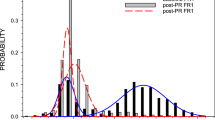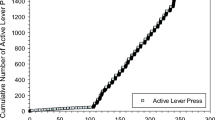Abstract
The effects of drugs on one aspect of impulsive behaviour were evaluated using a schedule in which rats were trained to complete a fixed consecutive number of responses on one of two levers before pressing the second to obtain a reinforcer (FCN). Terminating the chain before completing the FCN resulted in the omission of the food, and can be considered an impulsive decision. Two groups of food-deprived rats were trained to press either 8 or 32 times on the left lever (FCN lever) of a two lever operant chamber before pressing the right lever (Reinforcement lever) to deliver a food pellet. Responding on the Reinforcement lever before completion of the sequence resulted in a short time-out and the rat had to begin the sequence again. After responding had stabilised, the rats were treated with a range of doses of a number of drugs. Impulsivity was assessed by several measures, including the mean chain length and the proportion of chains terminating in food delivery, and the distribution of chain lengths was analysed. The efficiency of the rats was similar under both FCN 8 and FCN 32, although it was more difficult to maintain a consistent baseline under FCN 32. Under the FCN 8 schedule, significant decreases in chain length were obtained with d-amphetamine (0.8–2.4 mg/kg), haloperidol (0.1 mg/kg), ethanol (1 and 3 g/kg) and chlordiazepoxide (10.0 mg/kg), and there were alterations in other measures consistent with an increase in impulsivity. Imipramine (1–10 mg/kg), citalopram (1–10 mg/kg) and metergoline (0.3–3.0 mg/kg) had no effect on mean chain length, although the first two drugs shifted the chain length distribution to the left. d-Amphetamine (0.4–1.2 mg/kg) and PCPA (100 mg/kg) reduced chain length and had other effects consistent with increased impulsivity under FCN 32 schedule, whereas imipramine had little, and citalopram no, effect. Taken generally, effect of the active drugs was relatively non-specific, including both a reduction in response rate and alterations in choice measures proposed to reflect an increase in impulsivity. Detailed analysis of the effect of amphetamine revealed that three processes were at work: chain shortening, an increased preference for the lever most closely associated with food delivery, and a gradual shift in the control over responding from the response sequence (pattern) to the individual lever press (act).
Similar content being viewed by others
Author information
Authors and Affiliations
Additional information
Received: 24 April 1997 / Final version: 14 January 1998
Rights and permissions
About this article
Cite this article
Evenden, J. The pharmacology of impulsive behaviour in rats II: the effects of amphetamine, haloperidol, imipramine, chlordiazepoxide and other drugs on fixed consecutive number schedules (FCN 8 and FCN 32). Psychopharmacology 138, 283–294 (1998). https://doi.org/10.1007/s002130050673
Issue Date:
DOI: https://doi.org/10.1007/s002130050673




